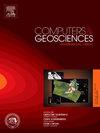Lithological mapping using Spatially Constrained Bayesian Network (SCB-Net): A deep learning model for generating field-data-constrained predictions with uncertainty evaluation using remote sensing data
IF 4.4
2区 地球科学
Q1 COMPUTER SCIENCE, INTERDISCIPLINARY APPLICATIONS
引用次数: 0
Abstract
Geological maps are an important source of information for the Earth sciences. These maps are created using numerical or conceptual models that use geological observations to extrapolate data. Geostatistical techniques have traditionally been used to generate reliable predictions that take into account the spatial patterns inherent in the data. However, as the number of auxiliary variables increases, these methods become more labor-intensive. Additionally, traditional machine learning methods often struggle to capture spatial context and extract valuable non-linear information from geoscientific datasets. To address these challenges, we developed the Spatially Constrained Bayesian Network (SCB-Net)—an architecture designed to effectively integrate auxiliary variables while generating spatially constrained predictions. SCB-Net employs a late-fusion strategy, processing auxiliary data and ground-truth information through two parallel encoding paths. Additionally, it leverages Monte Carlo dropout as a Bayesian approximation to quantify model uncertainty. The SCB-Net has been tested on two real-world datasets from northern Quebec, Canada, demonstrating its effectiveness in generating field-data-constrained lithological maps while providing uncertainty estimates for unsampled locations. Our method outperformed the Attention U-Net – a widely used model in image segmentation – by at least 4.7% in accuracy across all tested datasets.
使用空间约束贝叶斯网络(SCB-Net)的岩性制图:一种深度学习模型,用于生成现场数据约束预测,并使用遥感数据进行不确定性评估
地质图是地球科学的重要资料来源。这些地图是使用数值或概念模型创建的,这些模型使用地质观测来推断数据。传统上使用地质统计技术来产生考虑到数据中固有的空间模式的可靠预测。然而,随着辅助变量数量的增加,这些方法变得更加劳动密集型。此外,传统的机器学习方法往往难以捕获空间背景并从地球科学数据集中提取有价值的非线性信息。为了应对这些挑战,我们开发了空间约束贝叶斯网络(SCB-Net),这是一种架构,旨在有效地集成辅助变量,同时生成空间约束预测。SCB-Net采用后期融合策略,通过两条并行编码路径处理辅助数据和真值信息。此外,它利用蒙特卡罗dropout作为贝叶斯近似来量化模型的不确定性。SCB-Net已经在加拿大魁北克北部的两个真实数据集上进行了测试,证明了它在生成现场数据受限的岩性图方面的有效性,同时为未采样的位置提供了不确定性估计。我们的方法在所有测试数据集上的准确率至少比注意力U-Net(一种广泛使用的图像分割模型)高出4.7%。
本文章由计算机程序翻译,如有差异,请以英文原文为准。
求助全文
约1分钟内获得全文
求助全文
来源期刊

Computers & Geosciences
地学-地球科学综合
CiteScore
9.30
自引率
6.80%
发文量
164
审稿时长
3.4 months
期刊介绍:
Computers & Geosciences publishes high impact, original research at the interface between Computer Sciences and Geosciences. Publications should apply modern computer science paradigms, whether computational or informatics-based, to address problems in the geosciences.
 求助内容:
求助内容: 应助结果提醒方式:
应助结果提醒方式:


